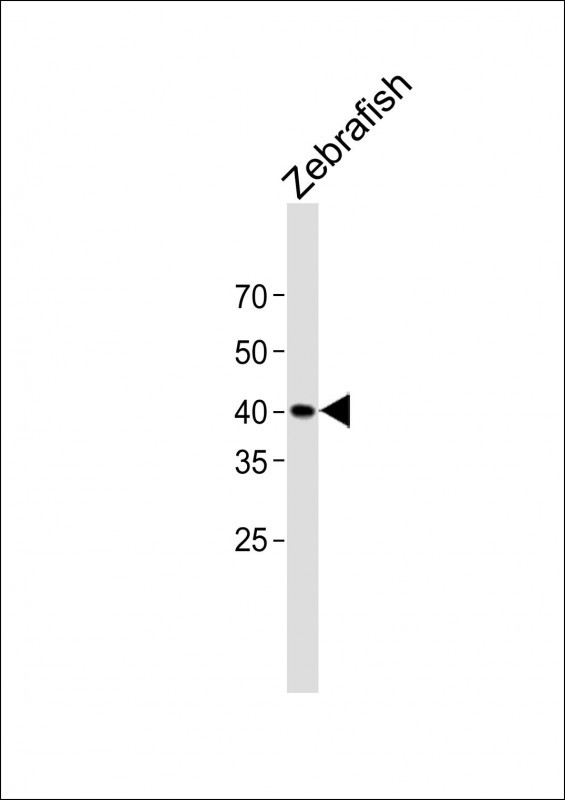(DANRE) aplnra Antibody (C-Term)
Purified Rabbit Polyclonal Antibody (Pab)
- 产品详情
- 实验流程
- 背景知识
Application
| WB, E |
|---|---|
| Primary Accession | Q7SZP9 |
| Reactivity | Zebrafish |
| Host | Rabbit |
| Clonality | polyclonal |
| Isotype | Rabbit IgG |
| Calculated MW | 40649 Da |
| Gene ID | 561935 |
|---|---|
| Other Names | Apelin receptor A, Angiotensin II receptor-like 1a, Angiotensin receptor-like 1a, G-protein coupled receptor APJ A, aplnra, agtrl1 {ECO:0000312|EMBL:ABI994701}, agtrl1a |
| Target/Specificity | This DANRE aplnra antibody is generated from a rabbit immunized with a KLH conjugated synthetic peptide between 343-377 amino acids from the human region of DANRE aplnra. |
| Dilution | WB~~1:1000 E~~Use at an assay dependent concentration. |
| Format | Purified polyclonal antibody supplied in PBS with 0.05% (V/V) Proclin 300. This antibody is purified through a protein A column, followed by peptide affinity purification. |
| Storage | Maintain refrigerated at 2-8°C for up to 2 weeks. For long term storage store at -20°C in small aliquots to prevent freeze-thaw cycles. |
| Precautions | (DANRE) aplnra Antibody (C-Term) is for research use only and not for use in diagnostic or therapeutic procedures. |
| Name | aplnra |
|---|---|
| Synonyms | agtrl1 {ECO:0000312|EMBL:ABI99470.1}, ag |
| Function | G protein-coupled receptor for peptide hormones apelin (apln) and apelin receptor early endogenous ligand (apela), that plays a role in the regulation of normal cardiovascular function and fluid homeostasis. When acting as apelin receptor, activates both G(i) protein pathway that inhibits adenylate cyclase activity, and the beta- arrestin pathway that promotes internalization of the receptor (PubMed:17336906, PubMed:24316148, PubMed:24407481). Also functions as mechanoreceptor that is activated by pathological stimuli in a G- protein-independent fashion to induce beta-arrestin signaling, hence eliciting cardiac hypertrophy. However, the presence of apelin ligand blunts cardiac hypertrophic induction from APLNR/APJ on response to pathological stimuli (By similarity). Plays a key role in early development such as gastrulation, blood vessels formation and heart morphogenesis by acting as a receptor for apela hormone, promoting endoderm and mesendoderm cell migration and regulating the migration of cells fated to become myocardial progenitors, respectively (PubMed:17336906, PubMed:24316148, PubMed:24407481, PubMed:26017639). Positively regulates angioblast migration toward the embryonic midline, i.e. the position of the future vessel formation, during vasculogenesis (PubMed:26017639). May promote sinus venosus (SV)-derived endothelial cells migration into the developing heart to promote coronary blood vessel development (By similarity). Required for cardiovascular development, particularly for intersomitic vein angiogenesis by acting as a receptor for apln hormone (By similarity). Also plays a role in various processes in adults such as regulation of blood vessel formation, blood pressure, heart contractility, and heart failure (By similarity). Acts redundantly with agtrl1b in heart development (PubMed:17336906). |
| Cellular Location | Cell membrane {ECO:0000250|UniProtKB:P79960}; Multi-pass membrane protein {ECO:0000250|UniProtKB:P79960} Note=Internalized to the cytoplasm after exposure to apelin (apln) After exposure to apelin receptor early endogenous ligand (apela), internalized from the cell surface into an endosomal recycling compartment, from where it is recycled to the cell membrane {ECO:0000250|UniProtKB:P35414, ECO:0000250|UniProtKB:P79960} |
| Tissue Location | First expressed before epiboly in dorsal precursors. During epiboly, expressed in the enveloping layer, yolk syncytial layer and migrating mesendoderm. During segmentation stages, expressed in epithelial structures such as adaxial cells, border cells of the newly formed somites, developing lens, otic vesicles and venous vasculature. |
For Research Use Only. Not For Use In Diagnostic Procedures.
Provided below are standard protocols that you may find useful for product applications.
BACKGROUND
Receptor for apelin coupled to G proteins that inhibit adenylate cyclase activity and plays a role in various processes in adults such as regulation of blood pressure, heart contractility, and heart failure. Also plays a key role in early development such as gastrulation and heart morphogenesis by acting as a receptor for apela hormone, promoting endoderm and mesendoderm cell migration and regulating the migration of cells fated to become myocardial progenitors, respectively (PubMed:24316148, PubMed:24407481). Acts redundantly with agtrl1b in heart development.
REFERENCES
Tucker B.,et al.Gene Expr. Patterns 7:258-265(2007).
Scott I.C.,et al.Dev. Cell 12:403-413(2007).
Chng S.C.,et al.Dev. Cell 27:672-680(2013).
Pauli A.,et al.Science 343:1248636-1248636(2014).
终于等到您。ABCEPTA(百远生物)抗体产品。
点击下方“我要评价 ”按钮提交您的反馈信息,您的反馈和评价是我们最宝贵的财富之一,
我们将在1-3个工作日内处理您的反馈信息。
如有疑问,联系:0512-88856768 tech-china@abcepta.com.























 癌症的基本特征包括细胞增殖、血管生成、迁移、凋亡逃避机制和细胞永生等。找到癌症发生过程中这些通路的关键标记物和对应的抗体用于检测至关重要。
癌症的基本特征包括细胞增殖、血管生成、迁移、凋亡逃避机制和细胞永生等。找到癌症发生过程中这些通路的关键标记物和对应的抗体用于检测至关重要。 为您推荐一个泛素化位点预测神器——泛素化分析工具,可以为您的蛋白的泛素化位点作出预测和评分。
为您推荐一个泛素化位点预测神器——泛素化分析工具,可以为您的蛋白的泛素化位点作出预测和评分。 细胞自噬受体图形绘图工具为你的蛋白的细胞受体结合位点作出预测和评分,识别结合到自噬通路中的蛋白是非常重要的,便于让我们理解自噬在正常生理、病理过程中的作用,如发育、细胞分化、神经退化性疾病、压力条件下、感染和癌症。
细胞自噬受体图形绘图工具为你的蛋白的细胞受体结合位点作出预测和评分,识别结合到自噬通路中的蛋白是非常重要的,便于让我们理解自噬在正常生理、病理过程中的作用,如发育、细胞分化、神经退化性疾病、压力条件下、感染和癌症。






